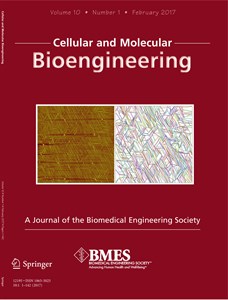 The research of Dr. Wonmuk Hwang, associate professor in the Department of Biomedical Engineering at Texas A&M University, has been featured on the February cover of the Cellular and Molecular Bioengineering (CMBE) journal.
The research of Dr. Wonmuk Hwang, associate professor in the Department of Biomedical Engineering at Texas A&M University, has been featured on the February cover of the Cellular and Molecular Bioengineering (CMBE) journal.
Hwang and his colleagues were recognized for the research article, “In Vitro Analysis of the Co-Assembly of Type-I and Type III Collagen.” The featured research focuses on the different types of collagen, how they co-assemble in different ratios and with the help of other additive molecules, generate an amazing diversity of biological tissues.
“Various tissues of the human body have been recently recognized as a biological ‘alloy’ or ‘amalgam,’” Hwang explained. “The knowledge of how their different components interact and control the resulting assembled structures is crucial for generating artificial tissues and developing better strategies for a wide range of applications such as wound healing and cancer detection and therapy.”
Collagen is the most abundant protein in humans and forms most of the solid tissues and structures. Although properties of individual constituent molecules have been extensively studied, far less is known about how they co-assemble together.
Initially, Hwang and his colleagues used the two most common collagen types, collagen-I and collagen-III. He found that mixing them at different ratios and observing how they assemble using atomic force microscopy does not lead to behavior that is intermediate between the two collagen types assembling separately. Instead, a subtle balance between their surface properties and propensity for assembly leads to more collagen fibrils forming rather than the assembly of pure collagen-I or collagen-III. The enhancement of nucleation is consistent with the increase in expression of collagen-III during the wound healing process or development of an organism, where rapid generation of fine and flexible fibrils would be desired.
For quantitative analysis of the experimental images, Hwang used the Computer-Aided Feature Extraction (CAFE) software that he is currently developing. This resulted in an impressive one-to-one match between the experimental image and the corresponding in silico model of the collagen fibril network, which was selected for the cover of the journal.
The formation of ordered biological structures via molecular self-assembly is a topic that has fundamental as well as practical significance and due to the complexity of the system, advanced computational analysis of imaging data is essential. In this regard, Hwang feels image analysis and image-based modeling may see an explosive growth in the coming years.
For more information regarding the article, visit: http://link.springer.com/article/10.1007/s12195-016-0466-3
For more information about Dr. Wonmuk Hwang, visit: /biomedical/people/hwang-wonmuk